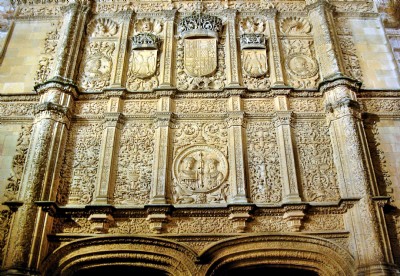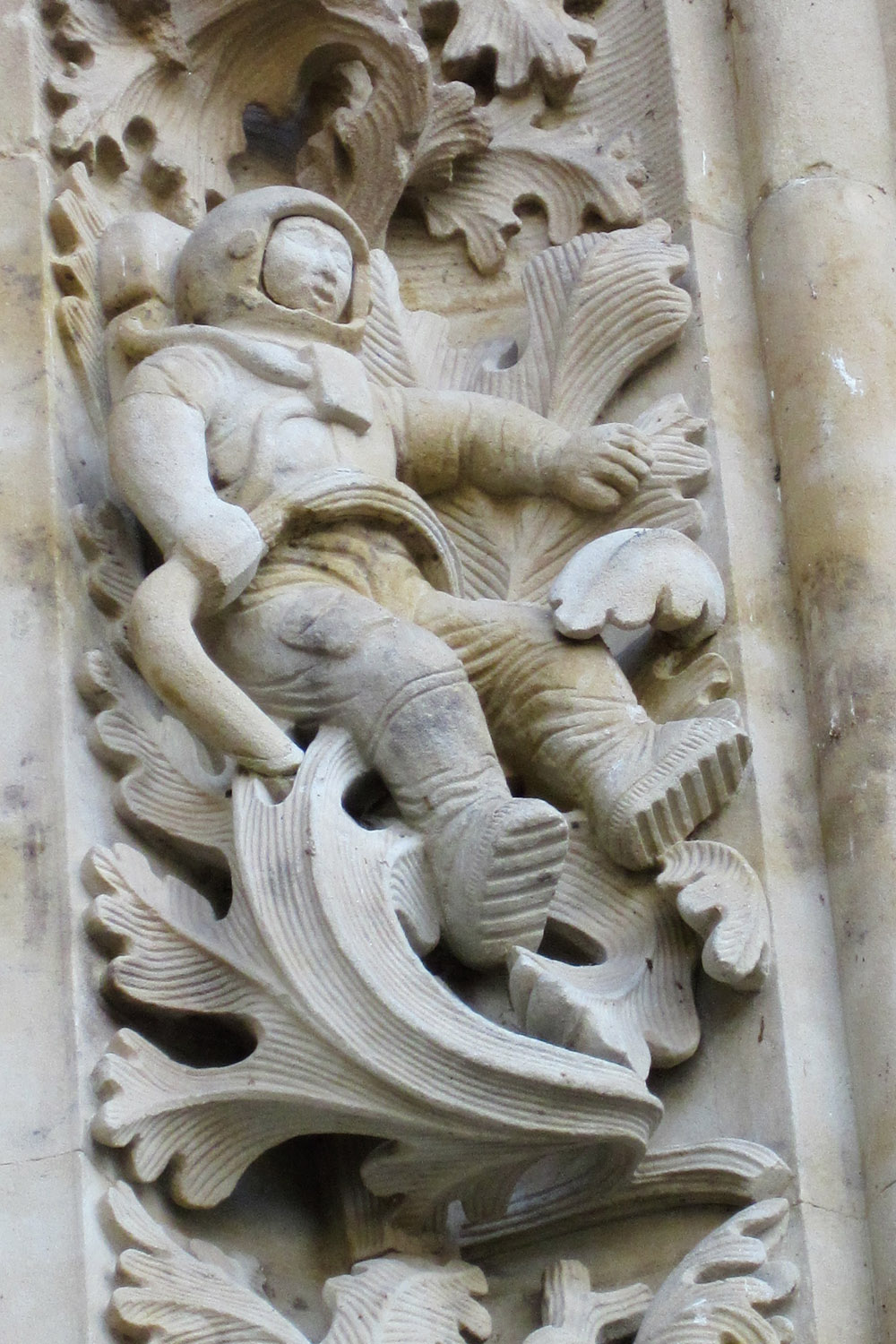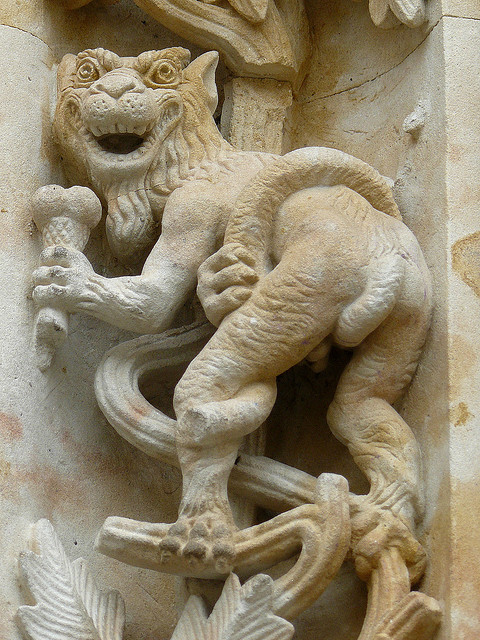 Salamanca, apart from being an old city known for its beautiful buildings and its university, has many hidden gems amongst them the mysterious carvings on two of it most renowned buildings. Students at the University of Salamanca, the oldest in Spain and third oldest in the world, are greeted with the old legend of the frog. It is presented as a challenge and ritual, that the students must spot the frog on the façade of the University, otherwise, they will not be able to graduate as doctors. This superstition still continues to this day and has also become a ritual for tourists in search of good luck, if you spot it without help you'll get more luck than chucking a coin into the Trivi Fountain. To find it you must go to La Puerta de Salamanca, the University’s façade. It’s a plateresque design intricately carved out of stone. However I am going to give you a clue, I wouldn't want anyone leaving there without their "good luck"- the frog can be found sitting on a skull. Apparently, after studies by an academic Benjamin Garcia-Hernández, the skull would represent Prince Juan of the Reyes Catolicos who died in 1497 just before turning 20 despite endless efforts by the "doctors" to save his life. The frog represents the physician who treated him, Doctor Parra, thus giving the frog its nickname "Parrita". So to help you out this is what you need to look for...
Salamanca, apart from being an old city known for its beautiful buildings and its university, has many hidden gems amongst them the mysterious carvings on two of it most renowned buildings. Students at the University of Salamanca, the oldest in Spain and third oldest in the world, are greeted with the old legend of the frog. It is presented as a challenge and ritual, that the students must spot the frog on the façade of the University, otherwise, they will not be able to graduate as doctors. This superstition still continues to this day and has also become a ritual for tourists in search of good luck, if you spot it without help you'll get more luck than chucking a coin into the Trivi Fountain. To find it you must go to La Puerta de Salamanca, the University’s façade. It’s a plateresque design intricately carved out of stone. However I am going to give you a clue, I wouldn't want anyone leaving there without their "good luck"- the frog can be found sitting on a skull. Apparently, after studies by an academic Benjamin Garcia-Hernández, the skull would represent Prince Juan of the Reyes Catolicos who died in 1497 just before turning 20 despite endless efforts by the "doctors" to save his life. The frog represents the physician who treated him, Doctor Parra, thus giving the frog its nickname "Parrita". So to help you out this is what you need to look for...
 However, nothing is more confusing to archaeologists and historians then old hoaxes, hoaxes that are now themselves parts of history and have caused hours and hours of wasted research. One of the most famous was the crystal skulls, for example, which were "discovered" in the jungles of Belize in the 1920s and said to be 3,600-year-old Mayan artefacts, but were actually carved in the 1840s, or the Voynich Manuscript, an undecipherable coded and illustrated manuscript from between the 1300s and 1400s, which is likely a series of gibberish meant to either discredit Jesuit Priest Athanasius Kircher, or possibly to gain fame and fortune for the unknown author.
However, nothing is more confusing to archaeologists and historians then old hoaxes, hoaxes that are now themselves parts of history and have caused hours and hours of wasted research. One of the most famous was the crystal skulls, for example, which were "discovered" in the jungles of Belize in the 1920s and said to be 3,600-year-old Mayan artefacts, but were actually carved in the 1840s, or the Voynich Manuscript, an undecipherable coded and illustrated manuscript from between the 1300s and 1400s, which is likely a series of gibberish meant to either discredit Jesuit Priest Athanasius Kircher, or possibly to gain fame and fortune for the unknown author.
 The thing that makes old hoaxes so frustrating is that they are hard to tease out from their actual history. Something fabricated in the 1600s made to look like it is from the 1400s can be very hard to pick out. However, this brings me to another carving on the facade of Salamanca's cathedral. An astronaut. Salamanca has two cathedrals, the old and the new. The Old Cathedral was built in the 12th century in the Romanesque style and it is dedicated to Saint Mary of the See. It is closed to the public and only opened during very special occasions. The New Cathedral is not exactly “new”. It was built between the 16th and 18th centuries in the Gothic and Baroque styles, commissioned by Ferdinand V of Castile of Spain, the Catholic King. For some time there were numerous debates online about the fact that one of the carvings is decidedly an astronaut. Obviously, there were no astronauts back in the 18th century, so some bright sparks deduced that it was evidence of time travel or ancient space travel via alien intervention. Some minds are easily influenced. The Astronaut is hidden in the carvings of the lateral entrance of the cathedral. Additionally more evidence to support these ridiculous theories was a gargoyle eating an ice-cream which also appears to be laughing at you. Which is rather ironic. But on this occasion neither are hoaxes even though they may appear to be.
The thing that makes old hoaxes so frustrating is that they are hard to tease out from their actual history. Something fabricated in the 1600s made to look like it is from the 1400s can be very hard to pick out. However, this brings me to another carving on the facade of Salamanca's cathedral. An astronaut. Salamanca has two cathedrals, the old and the new. The Old Cathedral was built in the 12th century in the Romanesque style and it is dedicated to Saint Mary of the See. It is closed to the public and only opened during very special occasions. The New Cathedral is not exactly “new”. It was built between the 16th and 18th centuries in the Gothic and Baroque styles, commissioned by Ferdinand V of Castile of Spain, the Catholic King. For some time there were numerous debates online about the fact that one of the carvings is decidedly an astronaut. Obviously, there were no astronauts back in the 18th century, so some bright sparks deduced that it was evidence of time travel or ancient space travel via alien intervention. Some minds are easily influenced. The Astronaut is hidden in the carvings of the lateral entrance of the cathedral. Additionally more evidence to support these ridiculous theories was a gargoyle eating an ice-cream which also appears to be laughing at you. Which is rather ironic. But on this occasion neither are hoaxes even though they may appear to be.
 The astronaut and the gargoyle on the Cathedral of Salamanca were both approved as a modern addition to the Cathedral, however, they have all the hallmarks of something which may provide for great confusion some 500 years from now. Built between 1513 and 1733, the Gothic cathedral underwent restoration work in 1992. It is generally a tradition of cathedral builders and restorers to add details or new carvings to the facade as a sort of signature. In this case, after conferring with the cathedral, quarryman Jeronimo Garcia was given the go-ahead to add some more modern images to the facade including an astronaut floating among some vines as well as the dragon eating ice cream. A lynx, a bull, and a crayfish were also added. The astronaut represents 20th-century technology and the gargoyle is said to represent the students of Salamanca.
The astronaut and the gargoyle on the Cathedral of Salamanca were both approved as a modern addition to the Cathedral, however, they have all the hallmarks of something which may provide for great confusion some 500 years from now. Built between 1513 and 1733, the Gothic cathedral underwent restoration work in 1992. It is generally a tradition of cathedral builders and restorers to add details or new carvings to the facade as a sort of signature. In this case, after conferring with the cathedral, quarryman Jeronimo Garcia was given the go-ahead to add some more modern images to the facade including an astronaut floating among some vines as well as the dragon eating ice cream. A lynx, a bull, and a crayfish were also added. The astronaut represents 20th-century technology and the gargoyle is said to represent the students of Salamanca.
So there you have it if you decide to visit Salamanca one day don't forget to pass by and pick up your dose of good luck and pay your respects to the ancient time travellers.
Good luck finding them!